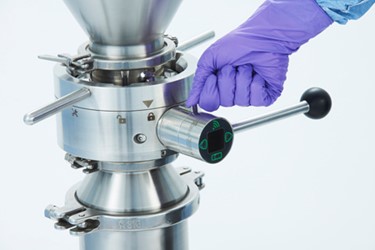Aseptic Split Butterfly Valve

ChargePoint Technology’s AseptiSafe range of transfer valves offers optimized product quality with increased sterility assurance, simple in-process sterilization, and high containment performance for hazardous products
ChargePoint’s aseptic powder transfer valves offer increased sterility assurance when handling sensitive ingredients and small components in fill/finish aseptic processing and biotech sterile API production.
The AseptiSafe® range provides multiple benefits to the user and the product process including
- Maintaining critical area integrity
- Removing the need for high air class control areas and cumbersome PPE
- Toxic powder processing whilst ensuring the safety of your personnel and a dust free environment
- Maximising yield transfer for poorly flowing and high value product
Several alternative methods of sterilising the AseptiSafe® valve contact and sealing faces are available to meet the critical area and process set-up requirements of our customers.
Our product range includes:
ChargePoint AseptiSafe®
- Sterilisation method: autoclave or/and SIP (steam in place)
- Offers a simple upgrade to GMP requirements in existing or new facilities
- SIP prior to material transfer
- Ideal for installation in higher grade cleanrooms with Isolator/RABS or existing LAF or other higher air class control systems
ChargePoint AseptiSafe® with HEPA LAF
- Sterilisation method: SIP/ISO5 HEPA LAF
- Ideal for installation in Grade B cleanrooms, providing a Grade A environment around the valve transfer interface
- Remote filter/fan unit supplies air to the terminal HEPA filter positioned next to the valve interface
- Offers a simple upgrade to GMP requirements in existing or new facilities
ChargePoint AseptiSafe® pro
Sterilisation method: SIP/ISO5 HEPA LAF
- In-board ports direct clean Grade A air directly across the valve interface
- Remote filter/fan unit supplies air to the terminal HEPA filter positioned next to the valve interface
- Can be used for high containment dust control with dust particulate collected from the second port and returned to air filtration in a closed loop system
How it works:
- The active unit uses SIP with the use of a passive unit.
- The two valve halves are docked together.
- The active unit is the driving half of the valve. Once operated the disc will open to allow the transfer of material through the valve. The active and passive interface is sealed to ensure no material can penetrate the critical area. Once the transfer has taken place the valve is closed.
- The active and passive units are then unlocked and undocked revealing the previously closed interfaces ensuring a clean transfer.
